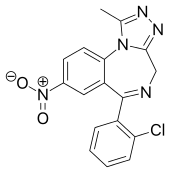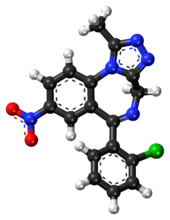Clonazolam
Clonazolam (also known as clonitrazolam) is a benzodiazepine that has had very little research done about its effects and metabolism, and has been sold online as a designer drug.[1][2][3][4][5]
 | |
 | |
| Clinical data | |
|---|---|
| Routes of administration | Oral |
| Legal status | |
| Legal status |
|
| Identifiers | |
IUPAC name
| |
| CAS Number | |
| PubChem CID | |
| ChemSpider | |
| UNII | |
| Chemical and physical data | |
| Formula | C17H12ClN5O2 |
| Molar mass | 353.77 g·mol−1 |
| 3D model (JSmol) | |
SMILES
| |
InChI
| |
The synthesis of clonazolam was first reported in 1971 and the drug was described as the most active compound in the series tested.[6][7]
Clonazolam is reported to be highly potent, and concerns have been raised that clonazolam and flubromazolam in particular may pose comparatively higher risks than other designer benzodiazepines, due to their ability to produce strong sedation and amnesia at oral doses of as little as 0.5 mg.[8]
Legality
United Kingdom
In the UK, clonazolam has been classified as a Class C drug by the May 2017 amendment to The Misuse of Drugs Act 1971 along with several other designer benzodiazepine drugs.[9]
United States
Virginia State Law has declared all of the following are now schedule I: clonazolam, etizolam, flualprazolam, flubromazolam, and flubromazepam.[10]
Clonazolam and flualprazolam are schedule I controlled substances under the Louisiana Uniform Controlled Dangerous Substances Law.
Sweden
Sweden's public health agency suggested classifying clonazolam as a hazardous substance on June 1, 2015.[11]
Effects
Clonazolam's effects are similar to other benzodiazepines, such as anxiolysis, disinhibition, lethargy, muscle relaxation, and euphoria. While no dose of clonazolam is considered "safe" due to its lack of research and extreme potency, doses higher than 0.5 mg can cause benzodiazepine overdose in some individuals. The effects of a benzodiazepine overdose include sedation, confusion, insufficient breathing, loss of consciousness, and death. Because dependence can occur in a short period of time, or even with a large initial dose, withdrawal symptoms may occur acutely, following the period of intoxication. These include seizures and can result in death.
See also
- Adinazolam
- Alprazolam
- Clonazepam, no triazole ring
- Estazolam, (licensed)
- Flubromazolam
- Pyrazolam
- Triazolam
References
- Laura M. Huppertz; Philippe Bisel; Folker Westphal; Florian Franz; Volker Auwärter; Bjoern Moosmann (July 2015). "Characterization of the four designer benzodiazepines clonazolam, deschloroetizolam, flubromazolam, and meclonazepam, and identification of their in vitro metabolites". Forensic Toxicology. 33 (2): 388–395. doi:10.1007/s11419-015-0277-6.
- Markus R. Meyer; Madeleine Pettersson Bergstrand; Anders Helander; Olof Beck (May 2016). "Identification of main human urinary metabolites of the designer nitrobenzodiazepines clonazolam, meclonazepam, and nifoxipam by nano-liquid chromatography-high-resolution mass spectrometry for drug testing purposes". Analytical and Bioanalytical Chemistry. 408 (13): 3571–3591. doi:10.1007/s00216-016-9439-6. PMID 27071765.
- M. Chaslot; S. El Balkhi; T. Robin; J. Morichon; N. Picard; F. Saint-Marcoux (June 2016). "Exploration des métabolites de 8 benzodiazépines de synthèse". Toxicologie Analytique et Clinique. 28 (2): S32. doi:10.1016/j.toxac.2016.03.053.
- Madeleine Pettersson Bergstrand; Anders Helander; Therese Hansson; Olof Beck (2016). "Detectability of designer benzodiazepines in CEDIA, EMIT II Plus, HEIA, and KIMS II immunochemical screening assays". Drug Testing and Analysis. 9 (4): 640–645. doi:10.1002/dta.2003. PMID 27366870.
- Høiseth, Gudrun; Tuv, Silja Skogstad; Karinen, Ritva (2016). "Blood concentrations of new designer benzodiazepines in forensic cases". Forensic Science International. 268: 35–38. doi:10.1016/j.forsciint.2016.09.006. PMID 27685473.
- Jackson B. Hester Jr.; Allan D. Rudzik; Bharat V. Kamdar (November 1971). "6-Phenyl-4H-s-triazolo[4,3-a] [1,4]benzodiazepines which have central nervous system depressant activity". Journal of Medicinal Chemistry. 14 (11): 1078–1081. doi:10.1021/jm00293a015. PMID 5165540.
- René Borer; Max Gerecke; Emilio Kyburz (22 October 1986). "Patent EP 0072029 B1 - Triazolobenzazepines, process and intermediates for their preparation and medicines containing them". Retrieved 6 August 2015.
- Bjoern Moosmann; Leslie A King; Volker Auwärter (June 2015). "Designer benzodiazepines: A new challenge". World Psychiatry. 14 (2): 248. doi:10.1002/wps.20236. PMC 4471986. PMID 26043347.
- "The Misuse of Drugs Act 1971 (Amendment) Order 2017".
- https://law.lis.virginia.gov/vacode/title54.1/chapter34/section54.1-3446/
- "23 nya ämnen kan klassas som narkotika eller hälsofarlig vara" (in Swedish). Folkhälsomyndigheten. Retrieved 6 August 2015.